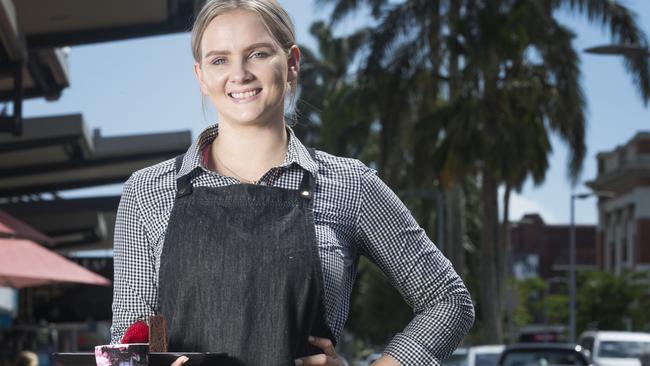Go Qld: Queensland’s economy went from powerhouse to laggard
“THERE are mega-forces at work,’’ says demographer Bernard Salt, who has looked at how Queensland has gone from a powerhouse to an economic laggard — and how we will get back on the track to prosperity.
Go QLD
Don't miss out on the headlines from Go QLD. Followed categories will be added to My News.
- Queensland economy: Bernard Salt’s report
- Peter Beattie: ‘Savage cocktail’ that led Queensland here
- The second capital city the state needs
- Palaszczuk: We are the best, now let’s prove it
HE first step towards recovery, it is said, is to recognise that you have a problem. Well, Queensland has a problem.
Coming off the high of a gas and coal rush which lasted more than a decade, the state is showing serious withdrawal symptoms.
What ideas and projects do you think will drive jobs and economic activity in Queensland? Comment below, tweet using #GoQld or email goqld@news.com.au.
Just two years ago, Queensland was still the country’s equal third best-performing economy. But the latest Commsec State of the States report, released in January, ranked us sixth — above Tasmania and South Australia.
“There are mega-forces at work,’’ says leading demographer Bernard Salt, who has conducted exclusive research for The Courier-Maillooking at how Queensland has gone from the nation’s powerhouse to an economic laggard — and how we will get back on the track to prosperity.
Bernard Salt’s report on the Queensland economy
“Australia is changing and Queensland is at the cutting edge of that change,” Mr Salt said.
“This is serious. We need to focus. We need the multi-billion dollar big-ticket infrastructure projects which trigger a visceral impact. We need to compete for the knowledge economy jobs of the future and plan for the sort of Queensland we want to live in, and that we want to leave for our children.’’

Mr Salt’s report, Envisioning A Better Queensland, compares life in the Sunshine State today with the pre-Global Financial Crisis period leading up to 2008, when it really was the land of opportunity.
Back then, with the resources sector supplementing an already successful broad economy — led by retail, construction, healthcare and manufacturing — the overriding concern was not job creation but finding enough staff.
The unemployment rate hit a record low 3.4 per cent in June 2007 and remained below 4 per cent for most the next year.
As the mining boom hoovered up every available worker in the regions — and those willing to relocate or adapt to a Fly In-Fly Out lifestyle — even McDonalds was forced to offer regular airfares home to recruit staff in Brisbane to flip burgers in Mt Isa.
The lure of plentiful work and an enviable lifestyle drew tens of thousands of interstate and overseas migrants each year — in turn generating additional demand for houses, schools, hospitals, shopping centres and other infrastructure and creating even more work.
Pockets bulging with high wages, household expenditure climbed by 6.7 per cent in 2007-08 as we spent up big on everything from cars to clothes and dining out.

In 2015 it rose just 2.6 per cent, with the growth on essentials such as food, health costs and insurance.
Brisbane’s median house price of $400,000 came close to matching Sydney’s $450,000 in late 2008. Today, at $500,000 here, you could virtually buy two homes for the $910,000 you would get selling a median-priced house in the harbour city.
Our economy outpaced the national average in 19 of the 22 years leading up to 2008. But it has done so only twice since.
What ideas and projects do you think will drive jobs and economic activity in Queensland? Comment below, tweet using #GoQld or email goqld@news.com.au.
During 2014-15, Queensland’s economy grew only 0.5 per cent, compared to the national average of 2.5 per cent.
“That’s narrowly escaping recession,’’ Chamber of Commerce and Industry advocacy director Nick Behrens said.
The Queensland Treasury forecasts growth of 4 per cent this financial year and 4.5 per cent next year.
But Mr Behrens said that was influenced by LNG exports which were having a limited flow-on benefit to the broader economy and job creation.

“Queensland was the state where you were guaranteed a very good livelihood and that’s no longer the case,’’ Mr Behrens said.
Business confidence has plummeted, with the Westpac-CCIQ Pulse survey for the December quarter showing 44 per cent of firms expecting the economy to weaken over the coming year.
“This has to be the year when the State Government has to start doing things,’’ Mr Behrens said.
“The patience that has been afforded to the State Government by the Queensland business community in 2015 will be converted to holding the Palaszczuk Government to account in 2016.’’
Read Bernard Salt’s report on Queensland’s economic situation
Mr Behrens welcomed Advance Queensland, the government’s central program to create knowledge-based jobs — but its funding of $180 million over four years was “ insignificant’’ in a $305 billion economy attempting to transition from a mining boom.
Wayne Gerard, a board member of technology entrepreneurs’ peak body StartupAUS, says Queensland can become a niche hub of technology expertise servicing industries such as tourism, agriculture, construction, mining and energy generation.
“There’s no reason we can’t build 1000 tech companies in this state, each employing 100 people — which would be a bigger workforce than mining ever had,’’ he said.
The mining sector’s direct workforce has fallen from just over 80,000 to about 60,000. But Queensland Resources Council says it still accounts for 327,400 related jobs — one in six of the state’s workers.

BIS Shrapnel chief economist Frank Gelber is blunt: “Forget mining. For some it was a super-cycle, but the reality is it was never going to last forever.
“We can go back to that but it will require adjustment. Queensland will not get out of this quickly. This will be a long, slow build.”
The legacy of the resources boom was the transformation of the state from “a branch office’’ to a major centre for professional services to support the mining sector — from legal, accounting and logistics services to planners, engineers and environmental scientists.
“Those that have survived are leaner and meaner. The challenge is really how you deploy those skills and services into other areas (of the economy),’’ Mr Gelber said.
“The things that drive the next 10 years will be very different to what drove the last 10.”
Bernard Salt’s report on the Queensland economy
Ironically, some are the very sectors which had suffered as a result of the high value of the Australia dollar, pushed up by mining’s success, and could now thrive on low exchange and interest rates.
They are tourism, agriculture and international education services — as well as financial services and manufacturing.
It is an attitude echoed by consultant Deloitte, which identified top growth opportunities as gas, water and waste services, information technology and food processing, as well as mining.
“It’s time for Queensland to stop looking back and to start exploiting the positives,’’ last month’s Deloitte Access Economics Queensland Business Outlook report urged.
“Much of the impact from the downturn in mining construction is behind us. And yes there was pain.
“But the cavalry is coming.’’


